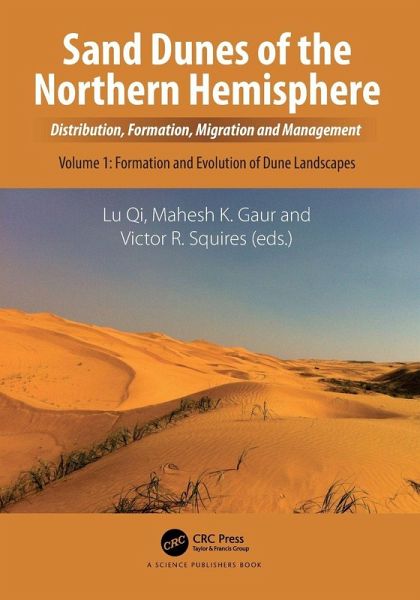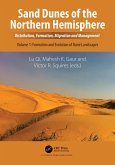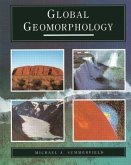Sand Dunes of the Northern Hemisphere
Distribution, Formation, Migration and Management, Volume 1
Herausgeber: Gaur, Mahesh K.; Squires, Victor R.; Lu, Qi
Sand Dunes of the Northern Hemisphere
Distribution, Formation, Migration and Management, Volume 1
Herausgeber: Gaur, Mahesh K.; Squires, Victor R.; Lu, Qi
- Broschiertes Buch
- Merkliste
- Auf die Merkliste
- Bewerten Bewerten
- Teilen
- Produkt teilen
- Produkterinnerung
- Produkterinnerung
Many chapters attempt to reconstruct past climatic changes in deserts and their margins at a variety of scales in space and time in the expectation that such information might assist in preparing us for future global warming and drying.
Andere Kunden interessierten sich auch für
![Sand Dunes of the Northern Hemisphere Sand Dunes of the Northern Hemisphere]() Sand Dunes of the Northern Hemisphere255,99 €
Sand Dunes of the Northern Hemisphere255,99 €![Geomorphology of Desert Dunes Geomorphology of Desert Dunes]() Nicholas LancasterGeomorphology of Desert Dunes87,99 €
Nicholas LancasterGeomorphology of Desert Dunes87,99 €![Global Geomorphology Global Geomorphology]() Michael A. SummerfieldGlobal Geomorphology85,99 €
Michael A. SummerfieldGlobal Geomorphology85,99 €![When the Sahara Was Green When the Sahara Was Green]() Martin WilliamsWhen the Sahara Was Green26,99 €
Martin WilliamsWhen the Sahara Was Green26,99 €![Across the Sand Across the Sand]() Hugh HoweyAcross the Sand18,99 €
Hugh HoweyAcross the Sand18,99 €![When the Sahara Was Green When the Sahara Was Green]() Martin WilliamsWhen the Sahara Was Green21,99 €
Martin WilliamsWhen the Sahara Was Green21,99 €![The Australian Desert The Australian Desert]() Roslynn HaynesThe Australian Desert51,99 €
Roslynn HaynesThe Australian Desert51,99 €-
-
-
Many chapters attempt to reconstruct past climatic changes in deserts and their margins at a variety of scales in space and time in the expectation that such information might assist in preparing us for future global warming and drying.
Hinweis: Dieser Artikel kann nur an eine deutsche Lieferadresse ausgeliefert werden.
Hinweis: Dieser Artikel kann nur an eine deutsche Lieferadresse ausgeliefert werden.
Produktdetails
- Produktdetails
- Verlag: Taylor & Francis Ltd
- Seitenzahl: 424
- Erscheinungstermin: 29. November 2024
- Englisch
- Abmessung: 178mm x 253mm x 24mm
- Gewicht: 912g
- ISBN-13: 9780367646073
- ISBN-10: 0367646072
- Artikelnr.: 71905960
- Herstellerkennzeichnung
- Libri GmbH
- Europaallee 1
- 36244 Bad Hersfeld
- gpsr@libri.de
- Verlag: Taylor & Francis Ltd
- Seitenzahl: 424
- Erscheinungstermin: 29. November 2024
- Englisch
- Abmessung: 178mm x 253mm x 24mm
- Gewicht: 912g
- ISBN-13: 9780367646073
- ISBN-10: 0367646072
- Artikelnr.: 71905960
- Herstellerkennzeichnung
- Libri GmbH
- Europaallee 1
- 36244 Bad Hersfeld
- gpsr@libri.de
Professor Lu Qi is Chief Scientist and Director of the Institute of Desertification Studies (IDS) in Beijing. The IDS is one of two such Institutes in the world. Dr. Lu has a PhD in Ecology from the Chinese Academy of Sciences, Beijing and is a specialist in Dryland Sustainable Development; Integrated ecosystem management/Desert Ecology and Combating desertification and Land degradation. He is the recipient of several prestigious awards: Three National Awards on Scientific & Technological Progress (Second Class, 2006/2009/2010) PRC National Award on International Science & Technology Cooperation (as Chinese Partner), 2008; Ningxia Hui Autonomous Region Award on Scientific & Technological Progress (First Class), 2008; and UNDP Best Practices Award on indigenous technology in combating desertification and mitigating the effect of drought. Dr. Lu is author/editor of 20 books notably A Study of Kumtagh Desert (in Chinese). Beijing: Science Press, 2012; Desert Plants in China (Illustrated Handbook, in Chinese). Beijing: China Forestry Publishing House, 2012; Rangeland Degradation and Recovery in China's Pastoral Lands, CABI, UK, 2009; Studies on Populus euphratica Forest in Ejina Oasis. Beijing: Science Press, 2009. Regional Review of UNCCD Implementation and Best Practices in Asia and the Pacific-Case Studies from Australia, China, Mongolia, Thailand and Viet Nam. Beijing: Chinese Environmental Science Press, 2005 and 180 papers (mostly in Chinese). Dr. Mahesh K. Gaur is an Indian, who is working at the ICAR-Central Arid Zone Research Institute, Jodhpur, India as a Principal Scientist, since September 2020. He worked as Senior Scientist from 2012 to 2020. He specializes in aridlands geography and the application of satellite remote sensing, GIS and digital image processing for natural resources mapping, management and assessment. He also researches drought, desertification, land degradation, indigenous knowledge systems, and the socio-economic milieu of the Thar Desert of India. Prior to this, he has worked as an Associate Professor for more than 13 years with the Department of Higher Education, Government of Rajasthan State, India and has also worked at Sandhan, Jaipur, IIM Ahmedabad, IHS Hyderabad and IN-RIMT in various capacities. He has also completed sponsored studies for ICAR, ISRO, SAC, UGC, and ICARDA. He has published 50 research papers in national and international research journals, 50 conference papers, 45 book chapters, five popular articles, and eight books. He is a member of a number of national and international scientific organizations, such as the Association of American Geographers and the Society for Conservation Biology, and several editorial boards of journals. He has been to South Africa, Namibia and Costa Rica on academic assignments. He is awarded the Citizen Karamveer Award 2011 by iCONGO for working in the field of Higher Education, Environment and Technology Applications for Community Upliftment; the Millennium Award for working in the field of Environment, and prestigious recognitions by the UGC of India and Scientific Assembly of the International Committee on Space Research (COSPAR). Dr. Victor R. Squires is a Distinguished Guest Professor in the Institute of Desertification Studies, Beijing. He is an Australian who as a young man studied animal husbandry and rangeland ecology. He has a PhD in Rangeland Science from Utah State University, USA. He is a former Foundation Dean of the Faculty of Natural Resource Management at the University of Adelaide, Australia where he worked for 15 years after a 22 year career in Australia's CSIRO. He is author/editor of 22 books on Drylands, Desertification, Ecological Restoration from such publishers as CRC Press, Springer, Routledge and Kluwer Academic and numerous research papers and invited book chapters. Since retirement from the University of Adelaide Dr. Squires was a Visiting Fellow in the East West Center, Hawaii, and an Adjunct Professor in the University of Arizona, Tucson and at the Gansu Agricultural University, Lanzhou, China. He has been a consultant to World Bank, Asian Development and various UN agencies in Africa, China, Central Asia and the Middle East. He was awarded the 2008 International Award and Gold Medal for International Science and Technology Cooperation by the Government of China and in 2011 was awarded the Friendship Award by the government of China. The Gold Medal is the highest award for foreigners. In 2015 Dr. Squires was honoured by the Society for Range Management (USA) with an Outstanding Achievement Award. Dr. Victor Squires was recognised in the 2021 Queen's birthday Honours with a member of the Order of Australia (AM), for services to ecology, especially rangelands.
Part 1: Methodologies for the Study and Utilization of Sand Dunes 1. A
Synoptic View of Northern Hemisphere Deserts and Sand Dunes: Perceptions,
Misconceptions and Distinctions 2. Advances in Measurement Techniques for
Estimating Sand Dune Movements 3. A Review of the Development in the Remote
Sensing of Sand Dunes 4. Applications of ICESat-2 Laser Altimeter Data for
Sand Dunes: Morphology and Dynamics Studies 5. New Perspectives on the
Occurrence and Characteristics of the Coastal Sand Dunes, North of Nile
Delta, Egypt 6. Algerian Sahara Sand Dune (Western Erg) Characterization:
An Experimental Study 7. Economic Heavy Minerals in the Coastal Area
Between Burg EL-Burullus and Baltim, North of Nile Delta, Egypt Part 2:
Dune Landscapes of China-Origins and Evolution 8. Formation of Dune Field
Landscape in North and North-West China during Plio-Pleistocene Transition
(4-2 Ma) and the Long-term Evolution 9. Formation, Evolution and Forcing
Mechanism of Feathered Sand Dunes in the Kumtag Desert, China 10.
Mega-Dune-Lake System in the Badain Jaran Sand Sea 11. Morphology,
Distribution and Formation of the Nebkhas on Gobi and Desert in China 12.
Type, Distribution, Formation and Evolution of Coastal Aeolian Dunes 13.
High-Altitude Aeolian Desertification and Sand Dunes on the Tibetan
Plateau, China 14. Characteristics, Dynamics, and Provenance of Sand Dunes
in the Hexi Corridor, China Part 3: Morphology and Distribution of Dune
Landscapes on the Indian Subcontinent 15. Dune Accumulation Chronologies
from the Thar Desert, India: A Review 16. Geomorphological Characteristics
of Sand Dunes and Evolution of Aeolian Landscape for Sustainable Future in
Western Thar Desert, Rajasthan, India 17. Late Quaternary Paleoenvironments
of the Eastern Margins of the Thar Desert, India-A Corridor for Human
Migration and Occupation 18. Geospatial Diversity, Geologic Significance
and Evolutionary Trends of Parabolic Dunes in Thar Desert of the Indian
Subcontinent 19. Sand Dunes Morphology and Migration in Shyok Valley,
Ladakh Himalaya, India 20. Coastal Sand Dunes of Southern India 21. Coastal
Sand Dunes along the Western and Eastern Shores of India 22. The Coastal
Zone of Sri Lanka: Characteristics, Problems and Prospects 23. Integrated
Coastal Zone Management: An Approach to Protect and Conserve the Morphology
and Ecology of Coastal Dune Systems of Bangladesh
Synoptic View of Northern Hemisphere Deserts and Sand Dunes: Perceptions,
Misconceptions and Distinctions 2. Advances in Measurement Techniques for
Estimating Sand Dune Movements 3. A Review of the Development in the Remote
Sensing of Sand Dunes 4. Applications of ICESat-2 Laser Altimeter Data for
Sand Dunes: Morphology and Dynamics Studies 5. New Perspectives on the
Occurrence and Characteristics of the Coastal Sand Dunes, North of Nile
Delta, Egypt 6. Algerian Sahara Sand Dune (Western Erg) Characterization:
An Experimental Study 7. Economic Heavy Minerals in the Coastal Area
Between Burg EL-Burullus and Baltim, North of Nile Delta, Egypt Part 2:
Dune Landscapes of China-Origins and Evolution 8. Formation of Dune Field
Landscape in North and North-West China during Plio-Pleistocene Transition
(4-2 Ma) and the Long-term Evolution 9. Formation, Evolution and Forcing
Mechanism of Feathered Sand Dunes in the Kumtag Desert, China 10.
Mega-Dune-Lake System in the Badain Jaran Sand Sea 11. Morphology,
Distribution and Formation of the Nebkhas on Gobi and Desert in China 12.
Type, Distribution, Formation and Evolution of Coastal Aeolian Dunes 13.
High-Altitude Aeolian Desertification and Sand Dunes on the Tibetan
Plateau, China 14. Characteristics, Dynamics, and Provenance of Sand Dunes
in the Hexi Corridor, China Part 3: Morphology and Distribution of Dune
Landscapes on the Indian Subcontinent 15. Dune Accumulation Chronologies
from the Thar Desert, India: A Review 16. Geomorphological Characteristics
of Sand Dunes and Evolution of Aeolian Landscape for Sustainable Future in
Western Thar Desert, Rajasthan, India 17. Late Quaternary Paleoenvironments
of the Eastern Margins of the Thar Desert, India-A Corridor for Human
Migration and Occupation 18. Geospatial Diversity, Geologic Significance
and Evolutionary Trends of Parabolic Dunes in Thar Desert of the Indian
Subcontinent 19. Sand Dunes Morphology and Migration in Shyok Valley,
Ladakh Himalaya, India 20. Coastal Sand Dunes of Southern India 21. Coastal
Sand Dunes along the Western and Eastern Shores of India 22. The Coastal
Zone of Sri Lanka: Characteristics, Problems and Prospects 23. Integrated
Coastal Zone Management: An Approach to Protect and Conserve the Morphology
and Ecology of Coastal Dune Systems of Bangladesh
Part 1: Methodologies for the Study and Utilization of Sand Dunes 1. A
Synoptic View of Northern Hemisphere Deserts and Sand Dunes: Perceptions,
Misconceptions and Distinctions 2. Advances in Measurement Techniques for
Estimating Sand Dune Movements 3. A Review of the Development in the Remote
Sensing of Sand Dunes 4. Applications of ICESat-2 Laser Altimeter Data for
Sand Dunes: Morphology and Dynamics Studies 5. New Perspectives on the
Occurrence and Characteristics of the Coastal Sand Dunes, North of Nile
Delta, Egypt 6. Algerian Sahara Sand Dune (Western Erg) Characterization:
An Experimental Study 7. Economic Heavy Minerals in the Coastal Area
Between Burg EL-Burullus and Baltim, North of Nile Delta, Egypt Part 2:
Dune Landscapes of China-Origins and Evolution 8. Formation of Dune Field
Landscape in North and North-West China during Plio-Pleistocene Transition
(4-2 Ma) and the Long-term Evolution 9. Formation, Evolution and Forcing
Mechanism of Feathered Sand Dunes in the Kumtag Desert, China 10.
Mega-Dune-Lake System in the Badain Jaran Sand Sea 11. Morphology,
Distribution and Formation of the Nebkhas on Gobi and Desert in China 12.
Type, Distribution, Formation and Evolution of Coastal Aeolian Dunes 13.
High-Altitude Aeolian Desertification and Sand Dunes on the Tibetan
Plateau, China 14. Characteristics, Dynamics, and Provenance of Sand Dunes
in the Hexi Corridor, China Part 3: Morphology and Distribution of Dune
Landscapes on the Indian Subcontinent 15. Dune Accumulation Chronologies
from the Thar Desert, India: A Review 16. Geomorphological Characteristics
of Sand Dunes and Evolution of Aeolian Landscape for Sustainable Future in
Western Thar Desert, Rajasthan, India 17. Late Quaternary Paleoenvironments
of the Eastern Margins of the Thar Desert, India-A Corridor for Human
Migration and Occupation 18. Geospatial Diversity, Geologic Significance
and Evolutionary Trends of Parabolic Dunes in Thar Desert of the Indian
Subcontinent 19. Sand Dunes Morphology and Migration in Shyok Valley,
Ladakh Himalaya, India 20. Coastal Sand Dunes of Southern India 21. Coastal
Sand Dunes along the Western and Eastern Shores of India 22. The Coastal
Zone of Sri Lanka: Characteristics, Problems and Prospects 23. Integrated
Coastal Zone Management: An Approach to Protect and Conserve the Morphology
and Ecology of Coastal Dune Systems of Bangladesh
Synoptic View of Northern Hemisphere Deserts and Sand Dunes: Perceptions,
Misconceptions and Distinctions 2. Advances in Measurement Techniques for
Estimating Sand Dune Movements 3. A Review of the Development in the Remote
Sensing of Sand Dunes 4. Applications of ICESat-2 Laser Altimeter Data for
Sand Dunes: Morphology and Dynamics Studies 5. New Perspectives on the
Occurrence and Characteristics of the Coastal Sand Dunes, North of Nile
Delta, Egypt 6. Algerian Sahara Sand Dune (Western Erg) Characterization:
An Experimental Study 7. Economic Heavy Minerals in the Coastal Area
Between Burg EL-Burullus and Baltim, North of Nile Delta, Egypt Part 2:
Dune Landscapes of China-Origins and Evolution 8. Formation of Dune Field
Landscape in North and North-West China during Plio-Pleistocene Transition
(4-2 Ma) and the Long-term Evolution 9. Formation, Evolution and Forcing
Mechanism of Feathered Sand Dunes in the Kumtag Desert, China 10.
Mega-Dune-Lake System in the Badain Jaran Sand Sea 11. Morphology,
Distribution and Formation of the Nebkhas on Gobi and Desert in China 12.
Type, Distribution, Formation and Evolution of Coastal Aeolian Dunes 13.
High-Altitude Aeolian Desertification and Sand Dunes on the Tibetan
Plateau, China 14. Characteristics, Dynamics, and Provenance of Sand Dunes
in the Hexi Corridor, China Part 3: Morphology and Distribution of Dune
Landscapes on the Indian Subcontinent 15. Dune Accumulation Chronologies
from the Thar Desert, India: A Review 16. Geomorphological Characteristics
of Sand Dunes and Evolution of Aeolian Landscape for Sustainable Future in
Western Thar Desert, Rajasthan, India 17. Late Quaternary Paleoenvironments
of the Eastern Margins of the Thar Desert, India-A Corridor for Human
Migration and Occupation 18. Geospatial Diversity, Geologic Significance
and Evolutionary Trends of Parabolic Dunes in Thar Desert of the Indian
Subcontinent 19. Sand Dunes Morphology and Migration in Shyok Valley,
Ladakh Himalaya, India 20. Coastal Sand Dunes of Southern India 21. Coastal
Sand Dunes along the Western and Eastern Shores of India 22. The Coastal
Zone of Sri Lanka: Characteristics, Problems and Prospects 23. Integrated
Coastal Zone Management: An Approach to Protect and Conserve the Morphology
and Ecology of Coastal Dune Systems of Bangladesh








